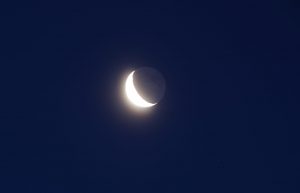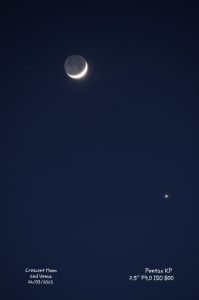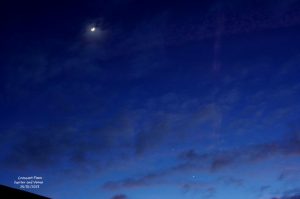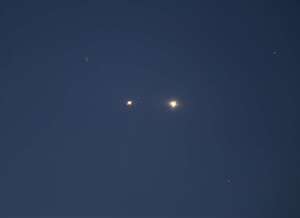Venus, Spica & Moon – 8th Dec 2023
Two super images by member Jim Burchell taken on the 8th Dec 2023. The 1st image shows Venus, the star Spica and the Moon going lower left to top right. Spica is the brightest star in the constellation of Virgo and one of the 20 brightest stars in the night sky. The 2nd image is of the Moon with Earthshine.


The Moon on the 8th December 2023 was 24.88 days old, 22.05% illuminated and in the Waning Crescent phase. This is the phase where the moon is less than 50% illuminated but has not yet reached 0% illumination which would be a New Moon.
Venus and a Crescent Moon by members Jim Burchell & Gary Hunt
Look towards the West after sunset for a splendid view of Venus and the crescent Moon over the next few evenings.
Members Jim Burchell and Gary Hunt did yesterday evening the 21st May 2023 and captured these great images of a young crescent Moon with Venus.
Moon & Venus by Jim Burchell

Moon & Venus by Gary Hunt

Venus & Mercury – 13th April 2023 by Diane Clarke.
Our rocky neighbours; Venus & Mercury taken by member Diane Clarke whilst at the pavilion on the 13th April 2023.

Venus & Pleiades by Jim Burchell – 10th April 2023
”The Pleiades are also known as The Seven Sisters, Messier 45 and other names by different cultures, is an asterism and an open star cluster containing middle-aged, hot B-type stars in the north-west of the constellation Taurus. At a distance of about 444 light years, it is among the nearest star clusters to Earth. It is the nearest Messier object to Earth, and is the most obvious cluster to the naked eye in the night sky. The cluster is dominated by hot blue luminous stars that have formed within the last 100 million years.” ref:https://en.wikipedia.org/wiki/Pleiades

Crescent Moon and Venus – 24th March 2023
Two lovely images of a crescent Moon, with Earthshine and Venus taken by member Jim Burchell on the 24th March 2023. The first image has the ISS in it too!


Images by Jim Burchell – 23rd to 25th Feb 2023
Member Jim Burchell was busy out and about towards the end of February photographing our stunning sky and below is a selection of his superb images.
Orion, Taurus and the Pleiades taken on the 23rd Feb from the CMHASD pavilion, Sutton-at-Hone.
Image was taken with a Pentax KP on a static tripod, F6.3, 30 sec, 18 MM and iso 800.

Crescent Moon on the 24th Feb.

The Sun taken on the 24th Feb.
NEVER LOOK AT THE SUN DIRECTLY. Please see our Solar Observing safety page at crayfordmanorastro.com/solar-safety/

Crescent Moon with Jupiter & Venus on the 25th Feb.

Jupiter & Venus – 22nd Jan 2023 by Jim Burchell
Two lovely photos taken by member Jim Burchell of the planets Jupiter & Venus on Sunday evening the 22nd Jan 2023. The photos were taken with a Pentax K70.


Venus & Crescent Moon by Jim Burchell
Two image’s of Venus in the morning sky both taken from Dartford top road by Jim Burchell on the 22nd and 26th June 2022.


Jupiter & Venus Conjunction 2022 by Richard Bohner
Whilst CMHASD member views of Venus & Jupiter from the UK were blocked by cloud, two superb images of Venus & Jupiter were captured in the early morning skies of the 28th & 30th April 2022 by member Richard Bohner in Arizona, USA.
The first image taken on the 28th at 04:30 MST was acquired using a Canon 6D, ISO 500 and an 8 second exposure time. Jupiter is on the left and Venus on the right and only 2.3 degrees apart.
The second image, taken on the 30th at 05:00 MST (using a Canon 6D, ISO 500 and a 6 second exposure time) shows Venus & Jupiter appearing even closer together, in fact very close. The planets were separated by the same angular distance as a full moon: about 1/2 degree!!! Three moons of Jupiter; Ganymede, Io and Callisto can also be seen in the 2nd image.
The Venus-Jupiter conjunction happens about once a year but this year the two planets appeared closer than they usually do. The last time the two planets were closer than this year’s conjunction was in August 2016 but it was more difficult to see since they were closer to the sun. The next time they will get this close is in 2039.
Jupiter & Venus 28th April 2022

Jupiter & Venus 30th April 2022

Although Venus and Jupiter appear next to each other in the sky they are nowhere near each other in space. The actual orbit of the planets is around 430 million miles apart (690 million km) nearly five times the Earth–sun distance!
You can also understand why the ancients called planets wanderers too.
Images by Jim Burchell

Auto Draft
Images By Diane Clarke
Conjunction of Mercury and Venus


Images of Venus by Richard Bohner
Images of Venus by Julian Tworek
An investigation into the phase anomaly of Venus
It has been known for some time that a difference between observed and theoretical phase of Venus is apparent, not only at dichotomy (Schroter’s Effect) but throughout the planet’s cycle, CMHAS conducted an experiment to study this effect.
Images of Venus by Simon Dawes
All images are copyright. Permission must be sought to from the image owner to the use of any of these images.
Other Images
Sun | Comets | Mercury | Venus | Atmospheric Optics | Meteors | Auroa and NLC | Moon | Minor Planets | Mars | Jupiter | Saturn | Uranus | Neptune | Messier | Caldwell | All Deep Sky | Conjunctions | Transits | Solar Eclipse | Lunar Eclipse | Wide Field |ISS & Space Junk | Exo-Planets




